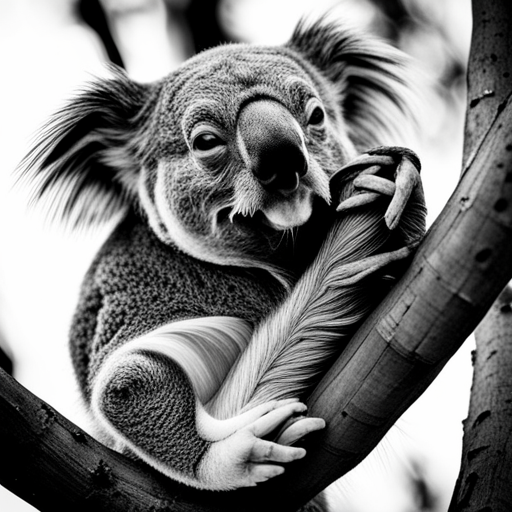Bamboo, specifically Phyllostachys bambusoides and Phyllostachys speciosa, is an essential component of their nutrition due to its high content of eucalyptus oil. Without bamboo, koalas would face severe nutrient deficiencies and potential starvation.
In the wild, koalas typically consume 200-400 grams of leaves per day, but during food scarcity, this intake can significantly increase to over 1,000 grams. Bamboo not only provides essential nutrients but also serves as a source of water content and fiber for koalas.
While bamboo leaves are tough and contain high levels of cellulose and lignin, koalas possess a specialized gut with bacteria that aids in breaking down cellulose, along with long intestines to facilitate bamboo digestion. However, excessive silica consumption from bamboo can lead to various health issues, including kidney disease, liver problems, and increased susceptibility to infections.
Understanding the role of bamboo in koalas’ diet is crucial for their conservation and management in both captive and wild settings.
Contents
- 1 Our Highlighted Points
- 2 What do they eat?
- 3 Importance of bamboo
- 4 Digestion process
- 5 Are Koalas the Only Animals That Eat Bamboo?
- 6 Frequently Asked Questions
- 6.1 Are there any other animals that eat bamboo besides koalas?
- 6.2 How do koalas find bamboo in the eucalyptus forests?
- 6.3 What are some health problems that can arise from excessive silica consumption in koalas?
- 6.4 Do koalas prefer certain types of bamboo over others?
- 6.5 Can captive koalas survive without bamboo in their diet?
Our Highlighted Points
- Koalas have a unique diet that includes eucalyptus leaves and bamboo.
- Bamboo, specifically Phyllostachys bambusoides and Phyllostachys speciosa, is an essential component of koalas’ nutrition due to its high content of eucalyptus oil.
- Without bamboo, koalas would face severe nutrient deficiencies and potential starvation.
What do they eat?

Koalas have a diverse diet consisting of bamboo, leaves, eucalyptus leaves, and insects. This dietary diversity is crucial for their survival. Bamboo plays a significant role in their diet as it contains eucalyptus oil, which is a major component of their nutrition.
In addition to bamboo, koalas also consume eucalyptus leaves and acacia leaves. The eucalyptus leaves provide essential nutrients and water content for their diet. It is worth noting that koalas primarily find bamboo in eucalyptus forests in southern Australia.
The consumption of bamboo and other leaves is essential for koalas as it provides the necessary nutrition, water, and fiber. Without bamboo, koalas would struggle to meet their nutritional needs and may face starvation. Their ability to digest cellulose, which is abundant in bamboo leaves, is facilitated by their specialized gut bacteria and long intestines. However, excessive silica consumption from bamboo can lead to health problems such as kidney disease, liver issues, and increased susceptibility to infections.
Importance of bamboo

Bamboo is a vital component of the koala’s diet due to its nutritional value and its role as a major source of eucalyptus oil.
The benefits of bamboo for koalas are manifold.
Firstly, bamboo provides essential nutrients that are necessary for the koala’s overall health and wellbeing. It contains a significant amount of water content, which helps to keep the koalas hydrated.
Additionally, bamboo is rich in fiber, which aids in digestion and promotes a healthy gut.
Moreover, bamboo serves as a crucial food source during periods of food scarcity, allowing koalas to sustain themselves when other food options are limited.
Furthermore, the role of bamboo in the koala habitat cannot be overstated. It is primarily found in eucalyptus forests, which are the preferred habitat of koalas.
Thus, bamboo not only provides sustenance but also plays a pivotal role in shaping the koala’s habitat.
Digestion process

The digestion process of the koala is facilitated by its specially adapted gut and the presence of bacteria that aid in the breakdown of cellulose.
Koalas have a unique gut adaptation that allows them to efficiently digest tough bamboo leaves. These leaves contain high levels of cellulose and lignin, which are difficult to break down. However, koalas have a specialized gut with bacteria that produce enzymes capable of breaking down cellulose. This allows the koalas to extract the nutrients from the bamboo leaves and utilize them for energy.
The long intestines of koalas, measuring around 4 meters (13 feet), further assist in the digestion process.
Through this intricate system, koalas are able to obtain the necessary nutrients from bamboo, ensuring their survival in their natural habitat.
Are Koalas the Only Animals That Eat Bamboo?
Koalas are commonly associated with being bambooloving animals and their preferences for this unique diet. However, they are not the only ones. Other animals like the red panda and the mountain gorilla also have a fondness for bamboo. Their diets demonstrate how diverse and fascinating nature can be.
Frequently Asked Questions
Are there any other animals that eat bamboo besides koalas?
Other animals, such as pandas and red pandas, also eat bamboo. These animals have unique digestive adaptations, including specialized gut bacteria and longer intestines, to aid in the breakdown of cellulose and lignin found in bamboo.
How do koalas find bamboo in the eucalyptus forests?
Koalas locate bamboo in eucalyptus forests through their feeding habits and the availability of bamboo in Australian forests. Their diverse diet includes bamboo, which provides essential nutrients and water content for their survival.
What are some health problems that can arise from excessive silica consumption in koalas?
Health problems caused by excessive silica consumption in koalas include dental wear and digestive issues. High silica exposure can lead to dental erosion, tooth loss, and gastrointestinal blockages, affecting the overall health and well-being of koalas.
Do koalas prefer certain types of bamboo over others?
Koalas show a preference for certain types of bamboo in their diet. Phyllostachys bambusoides and Phyllostachys speciosa are the main types consumed by koalas, as they provide essential nutrients and water content.
Can captive koalas survive without bamboo in their diet?
Captive koalas have specific nutritional needs, and while bamboo is an important part of their diet, they can survive without it by consuming alternative food sources such as eucalyptus leaves and acacia leaves.

